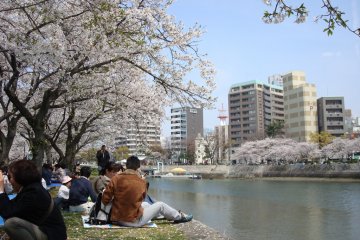
ฮะนะมิที่สวนอนุสรณ์สันติภาพฮิโรชิมา
Ashถ้าคุณอยู่ในประเทศญี่ปุ่น หรือวางแผนที่จะไปในช่วงเทศกาลดอกซากุระ และบางทีคุณไม่เคยคิดว่าฮิโรชิมาจะเป็นที่ชมดอกซากุระ

Hiroshima Peace Park (平和記念公園) is a large green space in the center of Hiroshima — once the thriving political and commercial heart of the city. On August 6th 1945, the world’s first atomic bomb was dropped over the center of Hiroshima City which suffered widespread damage and suffering. Four years later, this area of the city was designated as a memorial zone.
Today, the Hiroshima Peace Memorial Park, designed by Japanese architect Kenzo Tange, encompasses 30 acres and is home to numerous memorial statues, monuments and a world-class museum. Arguably the highlight of the park is the Peace Memorial Museum, which underwent a major renovation between 2017—2019. The museum focuses on the events of August 6th, with personal images and paraphernalia from the aftermath of the bomb—including a pocket watch that stopped at 8:15am, the time of the detonation.
At the north end of the park, the Atomic Bomb Dome (Gembaku Dome) is a skeletal reminder of the horror of that historic day. At 8:15am, the bomb detonated in the air directly over this area (the exact hypocenter a few blocks away), incinerating much of the city in its path but sparing this building’s metal framework, which remained intact. Today, the A-Bomb Dome serves as a visceral reminder of that fateful day.
Peace Memorial Park is a place of remembrance, perseverance and hope for a peaceful tomorrow.
President Obama made a historic visit to Hiroshima's Peace Park in 2016.
Take the street car (tram) #2 bound for Hiroden-Miyajima or #6 bound for Eba from JR Hiroshima Station. Alight at "Genbaku dome-mae" station.

ถ้าคุณอยู่ในประเทศญี่ปุ่น หรือวางแผนที่จะไปในช่วงเทศกาลดอกซากุระ และบางทีคุณไม่เคยคิดว่าฮิโรชิมาจะเป็นที่ชมดอกซากุระ

นกกระเรียนกระดาษนับพันตัวแต่งแต้มสีสัน ณ อนุสาวรีย์สันติภาพเด็กในสวนสันติภาพฮิโรชิม่า ซึ่งเด็กๆทั่วญี่ปุ่นต่างก็นำมาไว้ที่นี่

พร้อมกับพิพิธภัณฑ์อนุสรณ์สันติภาพ โดมปรมาณู (Atomic Bomb Dome) ฮิโรชิมะได้กลายมาเป็นสัญลักษณ์ข...

Hiroshima Peace Memorial Museum, located in southern Hiroshima, sits across from the Atomic Bomb Dome in the Peace Memorial Park. The museum houses information about Hiroshima’s history befor...

Santiago Guesthouse Hiroshima เป็นที่พักฮิปๆสไตล์แบคแพคเกอร์ ผู้เข้าพักที่นี่ส่วนใหญ่เป็นวัยรุ่นต่างชาติที่แบคแพคในญี่ปุ่น ที่พักแห่งนี้ถือว่าราคาถูกมากถ้าเทียบกับโรงแรมชั้นกลาง หากลองเปรียบเทียบราคาแล้วถือว่าถูกกว่าเกือบครึ่งนึงเลยทีเดียว
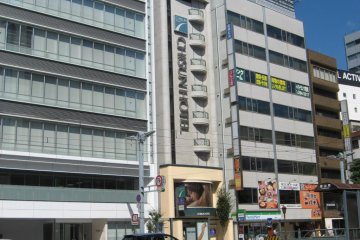
โรงแรมชิซุน ฮิโรชิม่าซึ่งตั้งอยู่ตรงกลางเมืองเป็นสถานที่ที่ดีต่อการพักอาศัยถ้าคุณกำลังวางแผนไปเยี่ยมชมเมืองที่โด่งดังระดับโลกแห่งนี้
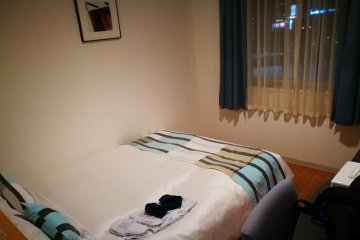
Hotel Flex เป็นโรงแรมที่ตั้งอยู่ริมแม่น้ำที่เกิดการบรรจบกันของแม่น้ำเคียวบาชิและแม่น้ำเอนโก วิวริมแม่น้ำถือเป็นจุดเด่นของโรงแรมแห่งนี้ สำหรับใครที่มาเที่ยวเมืองฮิโรชิมา แล้วอยากพักโรงแรมแบบสบายๆราคาเอื้อมถึง ขอให้ลองมาเข้าพักที่นี่ดู ชั้นล่างเป็นคาเฟ่ที่ถูกตกแต่งด้วยโทนสีสบายตา เข้ากับบรรยากาศริมแม่น้ำ ช่วงสายๆบ่ายๆ จะมีคนท้องถิ่นเข้ามานั่งพูดคุยจิบชา เพลินเพลินกับลมเย็นๆและบรรยากาศสบายๆ ห้องพักมีสิ่งอำนวยความสะดวกครบครัน แถมไม่ต้องเอาชุดนอนมาเพราะที่นี่มีชุดนอนลายน่ารักๆเอาไว้ให้ด้วย นอกจากนี้ เตียงยังมีขนาดใหญ่สำหรับนอนคนเดียวหรือสองคนได้อย่างสบาย ห้องค่อนข้างใหม่และสะอาด สามารถมองเห็นวิวยามค่ำคืนของเมืองฮิโรชิม่าได้ ข้างๆโรงแรมมีร้านสะดวกซื้อและร้านอาหารมากมาย ไม่ต้องกลัวหิว วิธีเดินทางมาก็สะดวก คือ เดินจากสถานีฮิโรชิมามาประมาณ 10 นาที แถวโรงแรมมีศูนย์เช่าจักรยานด้วย สามารถเช่าปั่นเล่นได้
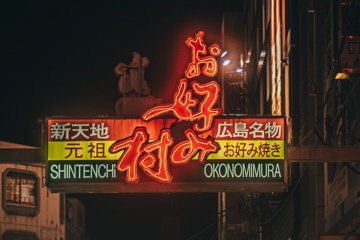
Okonomimura is a Hiroshima-style okonomiyaki theme park located in Shintenchi, Naka-ku, Hiroshima, near the east end of the Hondori shopping street. It has 24 okonomiyaki restaurants, each with a slightly different style and one different selection of ingredients. Okonomiyaki began in the pre-war period as a dish called "Issen Yoshoku" ("" Western food for a dime ""), which was very popular with common people. It consisted of a flour paste cooked with onions, dried shrimp, and spices. After the war, other ingredients such as cabbage, eggs, seafood, buckwheat and wheat noodles were used to improve the diet in these tough times. This is how today's Hiroshima-style okonomiyaki came about. [Photo: Victor Lee / CC BY-NC-ND 2.0]

โซบะจากแป้งบัควีดสไตล์ญี่ปุ่น พร้อมเครื่องเคียง และเครื่องดื่มเปิดให้บริการทุกวันตั้งแต่ 11:30 ถึง11:30 พร้อมเสิร์ฟอาหารถูกปากในราคาถูกใจ
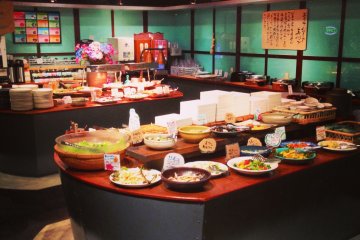
ผักสดๆจากฟาร์ม ชาบูชาบู และที่นั่งเหลือเฟือ... สิ่งเหล่านี้ทำให้ร้าน Roan เป็นร้านบุฟเฟต์ที่สูงกว่ามาตรฐานทั่วไป

"Carried to Hiroshima from Tinian Island by the Enola Gay, a U.S. Army B-29 bomber, the first atomic bomb used in the history of humankind, exploded approximately 580 meters above this spot. The city below was hit by heat rays of approximately 3,000 to 4,000°C, along with a blast wind and radiation. Most people in the area lost their lives instantly. The time was 8:15 a.m., August 6, 1945." This plaque on a downtown Hiroshima sidestreet marks the hypocenter of the Hiroshima atomic bombing, with the detonation of 'Little Boy' taking place 600 ft above this spot. Expect to see flowers or paper cranes left in memory at various times of the year.
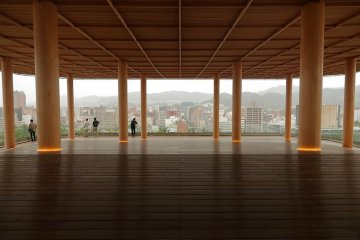
With its beautiful skylines and active waterways, Oizuru Tower offers its visitors a way to see all of that activity—day or night—unobstructed by glass or rails. The wooden floors and ceilings give off a gentle warmth and the pillars that support the ceilings also provide beams of light. Instead of glass or railings, guests can feel the Hiroshima air wash over them thanks to the stainless-steel net fence. With unobstructed views of Hiroshima, including the Peace Memorial Park and the Atomic Bomb Dome (and even Mount Misen of Miyajima on clear days), the tower offers viewers a way to feel at one with the city. Hiroshima Oizuru Tower is also home to an assortment of shops and cafés. Visit the first floor to find that special souvenir of one of Hiroshima’s local products at Hito to Ki. You’ll also find Hiroshima-style okonomiyaki in Akushu Café—including unique wrap-style okonomiyaki. On the 12th floor, you can also fold your own origami crane and leave it on the Oizuru Wall with your well wishes for the future. From the 12th floor to the 1st floor, there is a slide “cool-cool-cool” that runs alongside the spiral staircase. Why not try sliding your way down twelve floors—or just a couple, as you can exit in between floors. While you take a walk inside, browse the original comic created by Shuho Sato—manga artist of “Umizaru” and “Say Hello to Black Jack”—the works inside Oizuru Tower reflect on the theme of peace. No matter what you decide to do, you’ll be delighted by the spaces and experiences that you can create. Discover the past, present, and future of Hiroshima while you gaze out at this bustling city.

Hondori (本通) is one of the main shopping districts in Hiroshima's bustling downtown area. This pedestrian arcade street (shotengai) is a shopper's paradise, lined with everything from clothing stores, trendy boutiques, cafes and restaurants, through to karaoke bars, gaming arcades, purikura parlours and anime shops. When it comes to shopping in Hiroshima, Hondori is a popular choice. As a covered walkway, shoppers can also feel protected from the elements allowing plenty of time to find the perfect souvenir come rain or shine. Hondori is perfectly placed in the heart of Hiroshima's downtown and an easy, worthwhile stop on any Hiroshima itinerary. The street stretches for over half a kilometer from Peace Park in the west (near Sunmall), to the PARCO department store to the east (in the direction of Nagarekawa). It's easy to explore Hondori in combination with other sightseeing spots. For food, try local brands like Andersen's Bakery, the famous Okonomimura just off the eastern side, the well-known The Shack Bar and Grill, (moved from its original Chuodori location) or just keep things simple at the Starbucks on the eastern side — a popular meeting spot for locals, alongside the nearby Alice Garden. When shopping in Hiroshima, you can come across some interesting local chains, like Fresta, Wants and Edion (formerly DeoDeo)—not to mention some interesting heritage. Hiroshima is not just the home for Mazda, but also where it began for another global brand: Uniqlo. Just a few blocks away from Hondori towards Fukuromachi you can stumble across the building where the original branch for 'Unique Clothing Warehouse' (as it was originally known) started back in 1984. It's now occupied by a different business (Chacott), but easy to find being right next door to Hiroshima's branch of Paul Smith. Hondori is reliably busy at all times of the day, with many shops and cafes open until late. For a rainy day excursion, you can continue your shopping journey underground too — the entrance to the Kamiyacho Shareo underground mall can be located at the Hondori Streetcar stop.